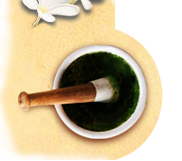


















We offer a very effective ayurveda treatment for Cervical Spondylitis. This is a very common disorder, normally seen in the elderly from the age of 55 onwards, cervical spondylitis today is increasingly frequent in the younger age group from 35 to 45 years of age. There are several reasons for this. Before coming to the pathophysiology, let us understand the developmental concepts.
Causes
This is basically a mechanical disorder. Very stiff muscles in the cervical region can, over the years, cause a kinking of the cervical spine to the front. Bad posture and lack of exercise to the cervical region are the key factors which are responsible in a majority of the patients. Lying in bed with several pillows propping up the neck into an unnatural position can affect the alignment of the cervical column, causing a forward inclination. Reclining on sofas with the spine hunched and the neck pushed forward is bad for cervical alignment. Hunching over the computer for many hours, occupational hazards such as those of a writer, an illustrator or a painter, all cause the spine to be bent forward all the time. Positioning the body to the same side during sleep, with the shoulder muscles and the neck compressed, also develops faulty alignment in the cervical spine. In due course the spine is bent, the front surface of the bones and disc are excessively pressurised and damage occurs. The so-called executive chairs are ill-designed and push the neck out of alignment. No chair should reach over the head. The level should be up to the shoulder blades so that the chest can stretch over the edge keeping the body upright.
In India, railway porters carry heavy loads on their heads but they do not suffer from cervical pain (as one would expect) from the heavy load they carry every day. Only in the group of people who never exercise their bodies does this occur most frequently.
Pathology
Essentially, the pathology consists of :
The problems of vascular insufficiency consist of vertigo, giddiness, occasional tinnitus (a ringing sensation in the inner ear), a sense of unsteadiness, etc. In a severe case, there is transient loss of consciousness. The vertebro-basilar vessels are important arteries coursing along the cervical column to the back of the brain There are areas here that subserve balance and posture. If the blood flow is affected, the corresponding function is also affected. As the anatomical arrangement is intricate, any movement in the neck affects the flow of blood in the arteries. This syndrome is known as vertebro-basilar -insufficiency.
Symptoms
The most common symptom is pain in the neck, worsening with exertion and relieved, in the early stages, by rest. This pain often radiates down to the hand, with the fingers becoming numb due to compression of the nerves that innervate the upper extremity. The brachial plexus is affected. The trapezius area becomes tender and painful. A nodule can form in the muscle due to chronic pressure. The symptoms of cervical cord compression can sometimes be severe. The pain radiates down the right or left arm to the fingers, to the chest and shoulder blades depending on which side the nerve root is involved. It can become continuous, making movements painful and limited. If the cervical vertebrae become unstable, the danger of cord compression is imminent and, in some cases, fusion of the bones may be warranted. But this is rare.
Do's
Don'ts
What are the bad postures that can worsen cervical spondylitis?